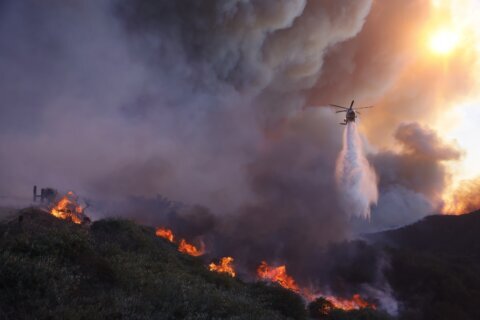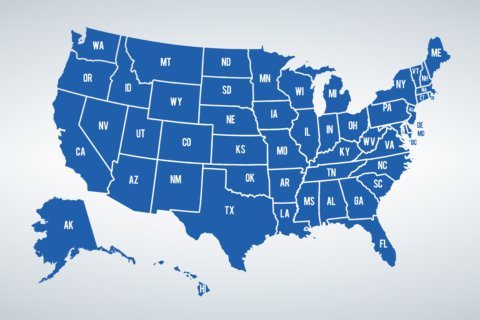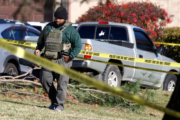
In Southern California, several large and fast-moving wildfires continue to devastate entire communities. The fires are fueled by dry conditions and strong Santa Ana winds.
“I wouldn’t have thought that we’d see this level of destruction,” Brian Fennessy, fire chief of the Orange County Fire Authority, told WTOP. He also represents the International Association of Fire Chiefs in McLean, Virginia, which works closely with elected leaders on wildfire and emergency management-related issues.
Fennessy’s department covers the county next to Los Angeles County, which has seen several fires move through and has teams helping their neighbors to the north.
There are several large fires burning out of control; among them was the Eaton Fire, which occurred east of the city of Los Angeles and has burned over 13,690 acres of land.
Fennessy, who has been a firefighter for more than 45 years, said he could not believe what he saw.
“I saw not only residential neighborhoods completely destroyed — not one house here, one house there — completely destroyed,” he said. “Commercial, large buildings, supermarkets — all on fire.”
“I’m still trying to get my head around it. It’s just that significant,” he added.
He said it is not typical to see wildfires spread to urban areas so quickly, and even with help from outside departments that arrived quickly, the fires moved too fast for firefighters to slow them down.
“Even with the resources that we had, had we had another 1,000 fire engines show up — this was a unique fire — I don’t know how much help that would have been,” Fennessy said.
Fennessy said for the first 48 hours, their priority wasn’t just about saving homes or businesses, it was getting people evacuated before the fires reached their neighborhoods.
He said it’s tough to get a handle on the fires without Mother Nature’s support, and the dry conditions and high wind gusts make it hard for crews to get the upper hand.
“There’s very little we’re going to be able to do, other than move people out of the way of these fires and try to pick up the small victories where we can,” he said.
Thankfully, Fennessy said the winds diminished a bit on Thursday, but there is still a concern that they’ll return in the coming days, carrying some dangerous embers in their wake.
“They’ll lodge under the eaves of a roof, they’ll get into an attic vent, they’ll get into a hedge,” Fennessy said. “Generally, what we’ve experienced is within 72 hours, anything that’s out there that’s laying dormant, but is still hot, will surface.”
He noted that those ember-bearing winds can make it hard to determine if a neighborhood has been affected, because when the embers land, firefighters may not see smoke right away.
He said the other concern is for the firefighters putting their lives on the line to fight the flames.
“It is a very hazardous environment when you’ve got winds like that, burning structure fires all around you,” he said.
Fennessy said his county is seeing the same conditions, but has luckily been spared so far. He’s called all staff in to make sure they’re ready to respond closer to home, too.
The mutual aid dilemma
When the first fires broke out, Chief Fennessy said the proper protocol is to use a government-operated system to request help. Using the system ensures the federal government would foot the bill for the extra help.
Fennessy said multiple states work together through a federally-funded program known as the “Emergency Management Assistance Compact,” and when the call for help needs to go out, the request must be submitted using a system called “Interagency Resource Ordering Capability” (IROC). Making that submission is cumbersome and time consuming, according to Fennessy.
Fennessy said using the system can delay the arrival of help for hours, or even as much as a day, so during this outbreak, local departments used a system they developed themselves.
“We’ve thrown up our hands, and said let’s develop our own and, yes, it’s based on phoning your neighbor, phoning a fire chief. And it drives the folks that manage the process crazy, because we worked outside the system, but the current system does not work,” he said.
Using this method does require departments to be concerned about needing to foot the bill if the federal government decides not to, but Fennessy said it’s a risk they’re willing to accept.
“The fire chiefs believe in this region, that it’s less about the reimbursement and more about getting resources to the public, to the communities, to the citizens that we need to get right now,” he said.
“We don’t have a day for resources to show up. They need to show up within hours — a couple of hours — or we’re going to see loss,” he added.
FEMA in a statement to WTOP said it is “aware of the issues fire departments experience” when using the IROC submission system. Since the fires, the agency said the fire administration has been on the ground “working to understand the technical issues with the IROC system.”
The U.S. Fire Administration is working to understand the technical issues with the IROC system on this particular response more precisely to inform near-term and future solutions.
FEMA also said reimbursement is not dependent on the use of a specific IT system and said it is considering alternative systems for departments to use, and whether that system will fully support the reimbursement process is being considered.
The agency said it has also started using another system, known as the National Emergency Response Information System, in November and once more stations are on it, it will help fire stations better know what resources are available from other departments.
Fennessy said wildfire outbreaks elsewhere in the nation show the need for a better mutual aid system, because knowing where fire resources are and what equipment is available, is critical in times like these.
“We need a national mutual aid system where we can reach out very quickly and get resources from all over the country moving to areas that need them,” he said.
Get breaking news and daily headlines delivered to your email inbox by signing up here.
© 2025 WTOP. All Rights Reserved. This website is not intended for users located within the European Economic Area.








